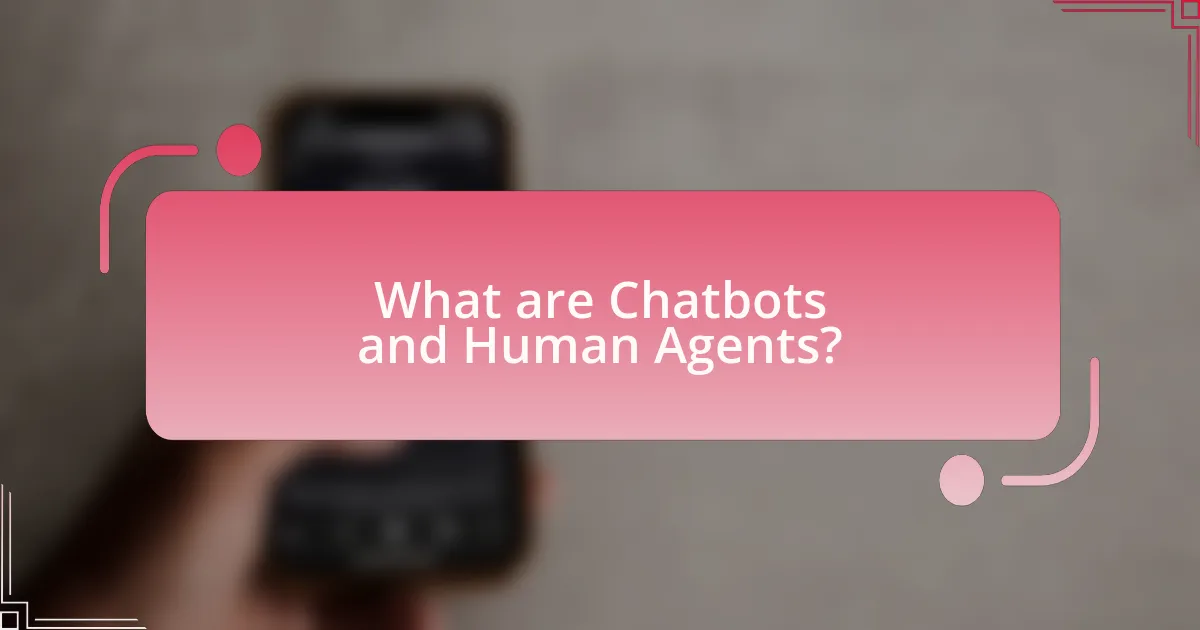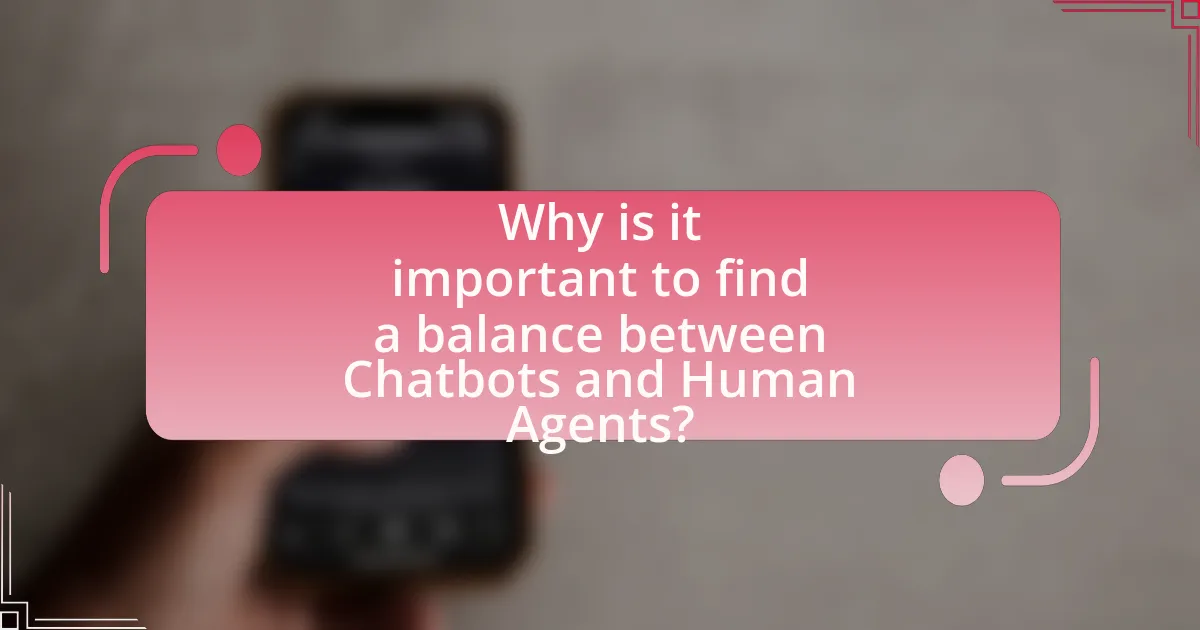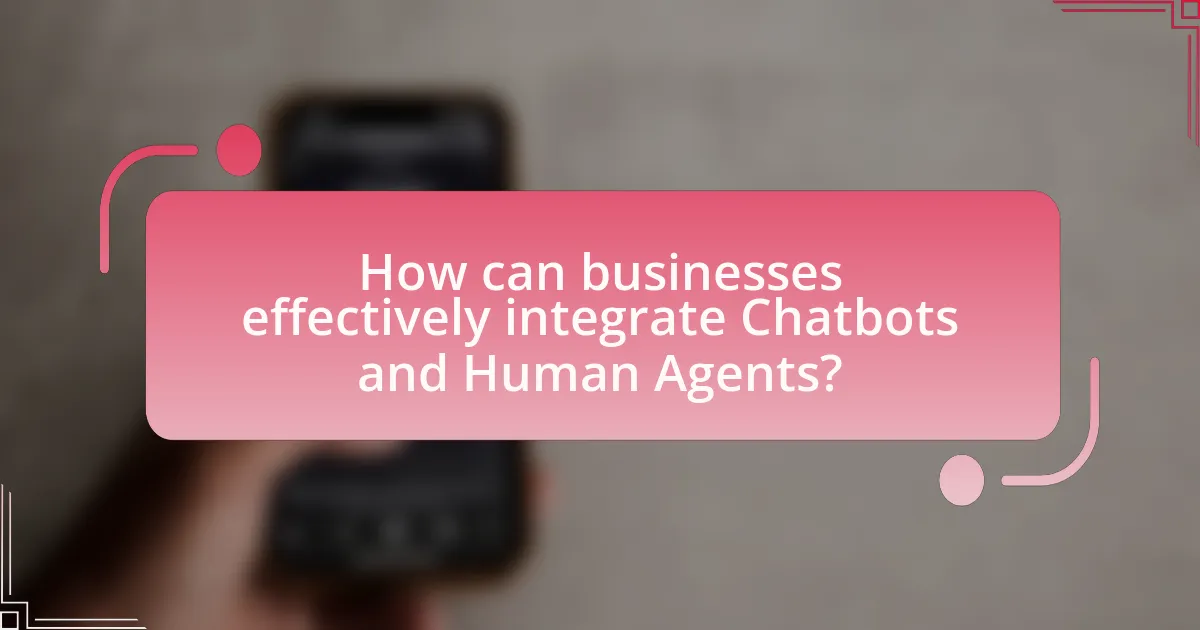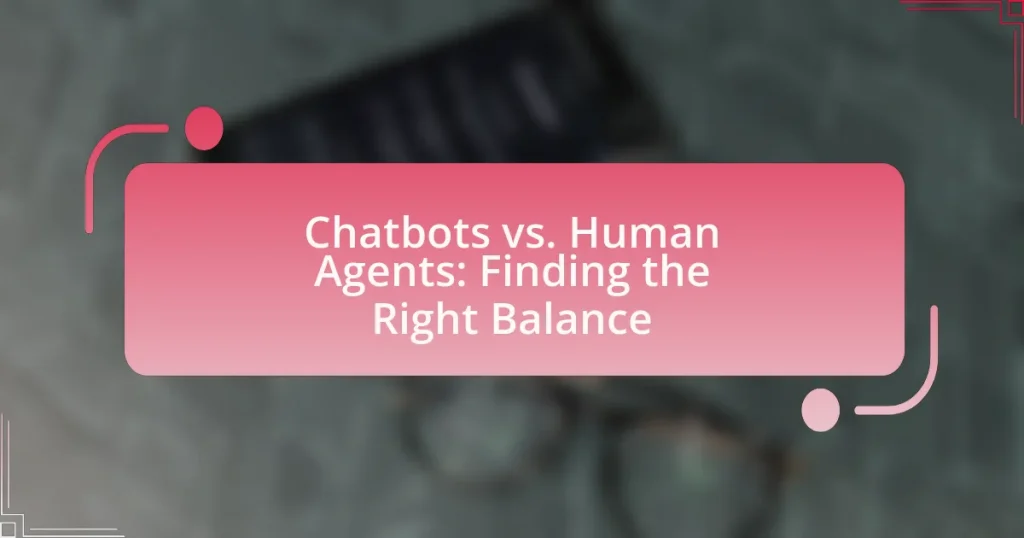The article focuses on the comparison between chatbots and human agents in customer service, emphasizing the importance of finding an effective balance between the two. It outlines the functionalities of chatbots, including their reliance on artificial intelligence and natural language processing to automate customer interactions, while highlighting the critical roles human agents play in addressing complex inquiries that require empathy and nuanced understanding. The discussion includes the advantages and limitations of both chatbots and human agents, strategies for their integration, and best practices for optimizing customer service efficiency and satisfaction. Key findings indicate that while chatbots can handle routine tasks, human agents are essential for fostering customer loyalty and resolving intricate issues.

What are Chatbots and Human Agents?
Chatbots are automated software programs designed to simulate conversation with users, often utilizing artificial intelligence to understand and respond to inquiries. Human agents, on the other hand, are real individuals who provide customer support and assistance, leveraging personal experience and emotional intelligence to address complex issues. The effectiveness of chatbots is evidenced by a report from Gartner, which states that by 2022, 70% of customer interactions will involve emerging technologies like chatbots, highlighting their growing role in customer service. In contrast, human agents are essential for handling nuanced situations that require empathy and critical thinking, as noted in a study by McKinsey, which found that human interaction remains crucial for customer satisfaction in complex scenarios.
How do Chatbots function in customer service?
Chatbots function in customer service by utilizing artificial intelligence to automate interactions with customers, providing instant responses to inquiries. They analyze user input through natural language processing, allowing them to understand and respond to questions, resolve issues, and guide users through processes without human intervention. According to a report by Gartner, by 2022, 70% of customer interactions were expected to involve emerging technologies like chatbots, highlighting their growing role in enhancing customer service efficiency and availability.
What technologies power Chatbots?
Chatbots are powered by several key technologies, including Natural Language Processing (NLP), machine learning, and artificial intelligence (AI). NLP enables chatbots to understand and interpret human language, allowing for effective communication. Machine learning algorithms help chatbots learn from interactions and improve their responses over time. AI enhances the decision-making capabilities of chatbots, enabling them to provide more accurate and contextually relevant answers. These technologies collectively contribute to the functionality and efficiency of chatbots in various applications, such as customer service and personal assistance.
What are the limitations of Chatbots?
Chatbots have several limitations, including their inability to understand complex human emotions and nuances in conversation. Unlike human agents, chatbots often struggle with context, leading to misunderstandings or irrelevant responses. Additionally, they may lack the capability to handle intricate queries that require critical thinking or creativity. Research indicates that 70% of consumers prefer human interaction for complex issues, highlighting the inadequacy of chatbots in such scenarios. Furthermore, chatbots can be limited by their programming, which restricts their ability to learn from new interactions effectively, resulting in a static knowledge base that may not adapt to evolving user needs.
What roles do Human Agents play in customer service?
Human agents play critical roles in customer service by providing personalized support, resolving complex issues, and enhancing customer satisfaction. They are essential for handling inquiries that require empathy, nuanced understanding, and human judgment, which automated systems often struggle to achieve. According to a study by PwC, 82% of consumers prefer human interaction for complex problem-solving, highlighting the importance of human agents in delivering effective service. Additionally, human agents can build rapport with customers, fostering loyalty and trust, which are vital for long-term business relationships.
How do Human Agents handle complex inquiries?
Human agents handle complex inquiries by utilizing their critical thinking skills, emotional intelligence, and extensive knowledge base to analyze and resolve issues effectively. They engage in active listening to fully understand the customer’s concerns, ask clarifying questions, and provide tailored solutions based on the specific context of the inquiry. This approach is supported by studies indicating that human agents can adapt their responses based on emotional cues and nuanced information, which enhances customer satisfaction and problem resolution rates. For instance, research from the Harvard Business Review highlights that human agents are more effective in resolving complex issues than automated systems, particularly when empathy and understanding are required.
What skills are essential for Human Agents?
Essential skills for Human Agents include effective communication, problem-solving, empathy, and adaptability. Effective communication allows agents to convey information clearly and understand customer needs. Problem-solving skills enable agents to address and resolve issues efficiently, while empathy helps them connect with customers on a personal level, enhancing the overall experience. Adaptability is crucial as it allows agents to adjust to varying customer demands and technological changes. These skills are supported by research indicating that customer satisfaction is significantly influenced by the quality of human interaction in service roles.

Why is it important to find a balance between Chatbots and Human Agents?
Finding a balance between chatbots and human agents is crucial for optimizing customer service efficiency and satisfaction. Chatbots can handle routine inquiries quickly, reducing wait times and operational costs, while human agents are essential for addressing complex issues that require empathy and nuanced understanding. Research indicates that 70% of customer interactions can be automated, yet 30% still necessitate human intervention for effective resolution. This balance ensures that businesses can provide timely responses while maintaining a high level of service quality, ultimately leading to improved customer loyalty and retention.
What are the advantages of using Chatbots?
Chatbots offer several advantages, including 24/7 availability, cost efficiency, and the ability to handle multiple inquiries simultaneously. Their constant availability ensures that users receive immediate responses at any time, enhancing customer satisfaction. Cost efficiency is evident as businesses can reduce operational costs by automating routine tasks, which allows human agents to focus on more complex issues. Additionally, chatbots can manage thousands of interactions at once, significantly increasing response capacity compared to human agents, who can only handle one conversation at a time. These factors contribute to improved service efficiency and customer engagement.
How do Chatbots improve efficiency in customer service?
Chatbots improve efficiency in customer service by providing instant responses to customer inquiries, which reduces wait times and enhances user satisfaction. They can handle multiple queries simultaneously, allowing businesses to scale their support without increasing staff. According to a study by IBM, chatbots can resolve up to 80% of routine customer inquiries, significantly decreasing the workload on human agents and enabling them to focus on more complex issues. This efficiency leads to faster service delivery and improved overall customer experience.
What cost savings can businesses achieve with Chatbots?
Businesses can achieve significant cost savings with chatbots by reducing the need for human customer service agents. Implementing chatbots can lower operational costs by up to 30%, as they can handle multiple inquiries simultaneously without the need for breaks or salaries. For instance, a study by Juniper Research estimates that chatbots will help businesses save over $8 billion annually by 2022 through improved efficiency and reduced labor costs. Additionally, chatbots can operate 24/7, providing continuous support without incurring extra costs, which further enhances their cost-saving potential.
What are the benefits of Human Agents in customer interactions?
Human agents provide personalized support in customer interactions, enhancing customer satisfaction and loyalty. Their ability to empathize and understand complex issues allows for tailored solutions that automated systems often cannot deliver. Research indicates that 70% of customers prefer human interaction for resolving complicated problems, highlighting the effectiveness of human agents in fostering trust and rapport. Additionally, human agents can adapt their communication style to suit individual customer needs, further improving the overall experience.
How do Human Agents enhance customer satisfaction?
Human agents enhance customer satisfaction by providing personalized and empathetic interactions that address individual customer needs. Unlike automated systems, human agents can understand complex issues, offer tailored solutions, and build rapport with customers, which significantly improves the overall experience. Research indicates that 70% of customers prefer human interaction for resolving complex issues, as they feel more valued and understood when speaking to a person rather than a machine. This ability to connect on a personal level leads to higher customer loyalty and satisfaction rates.
What unique value do Human Agents provide that Chatbots cannot?
Human agents provide emotional intelligence and nuanced understanding that chatbots cannot replicate. While chatbots can handle straightforward queries and provide information based on programmed responses, human agents can interpret complex emotions, empathize with customers, and adapt their communication style to suit individual needs. For instance, a study by the Harvard Business Review found that 70% of customers prefer human interaction for resolving complex issues, highlighting the importance of human empathy and understanding in customer service. This ability to connect on a personal level and navigate intricate situations is a unique value that human agents offer, which chatbots lack.

How can businesses effectively integrate Chatbots and Human Agents?
Businesses can effectively integrate chatbots and human agents by establishing a clear workflow that delineates tasks suited for automation versus those requiring human intervention. This integration can be achieved through the use of chatbots for handling routine inquiries, such as FAQs and basic customer support, while human agents manage complex issues that require empathy and nuanced understanding.
For instance, a study by Gartner indicates that by 2025, 75% of customer service interactions will be powered by AI, highlighting the importance of chatbots in streamlining operations. Furthermore, implementing a seamless handoff process between chatbots and human agents ensures that customers receive timely assistance without frustration. This approach not only enhances customer satisfaction but also optimizes resource allocation, allowing human agents to focus on higher-value tasks.
What strategies can be employed for optimal integration?
To achieve optimal integration of chatbots and human agents, organizations should implement a hybrid model that leverages the strengths of both. This strategy involves using chatbots for routine inquiries and data collection, while human agents handle complex issues requiring empathy and nuanced understanding. Research indicates that companies employing such hybrid approaches see a 30% increase in customer satisfaction, as chatbots efficiently manage high-volume tasks, allowing human agents to focus on more intricate customer needs. This balance not only enhances operational efficiency but also improves the overall customer experience.
How can businesses determine the right tasks for Chatbots?
Businesses can determine the right tasks for chatbots by analyzing customer interactions and identifying repetitive queries that can be automated. By reviewing frequently asked questions and common customer service scenarios, businesses can pinpoint areas where chatbots can efficiently handle inquiries, such as providing product information, processing orders, or scheduling appointments. Research indicates that chatbots can manage up to 80% of standard customer inquiries, allowing human agents to focus on more complex issues that require emotional intelligence or nuanced understanding. This strategic task allocation enhances operational efficiency and improves customer satisfaction.
What training is necessary for Human Agents to work alongside Chatbots?
Human agents require training in technology use, communication skills, and problem-solving to effectively work alongside chatbots. Training in technology use ensures agents understand chatbot functionalities and can manage interactions seamlessly. Communication skills training enhances agents’ ability to interpret chatbot outputs and respond appropriately to customer inquiries. Problem-solving training equips agents to handle complex issues that chatbots may not resolve, ensuring a smooth transition between automated and human support. This multifaceted training approach is essential for optimizing the collaboration between human agents and chatbots, ultimately improving customer service efficiency.
What are common challenges in balancing Chatbots and Human Agents?
Common challenges in balancing chatbots and human agents include ensuring effective communication, managing customer expectations, and addressing complex queries. Effective communication is crucial as chatbots may struggle with nuanced language, leading to misunderstandings. Managing customer expectations is another challenge, as users may expect chatbots to handle all inquiries, which can result in frustration when complex issues arise that require human intervention. Additionally, addressing complex queries often necessitates human agents, as chatbots may lack the contextual understanding needed for intricate problems. These challenges highlight the need for a well-defined strategy that integrates both chatbots and human agents to optimize customer service.
How can businesses address customer frustration with Chatbots?
Businesses can address customer frustration with chatbots by implementing a hybrid model that combines automated responses with human support. This approach allows customers to receive immediate assistance for simple inquiries while ensuring that complex issues are escalated to human agents. Research indicates that 70% of consumers prefer to interact with a human when dealing with complicated problems, highlighting the importance of this balance. Additionally, regularly updating chatbot algorithms based on customer feedback can enhance their effectiveness, as 61% of users report dissatisfaction when chatbots fail to understand their queries. By prioritizing user experience and providing seamless transitions to human agents, businesses can significantly reduce customer frustration with chatbots.
What measures can be taken to ensure seamless transitions between Chatbots and Human Agents?
To ensure seamless transitions between chatbots and human agents, implementing a robust handoff protocol is essential. This protocol should include clear guidelines for when and how to escalate a conversation from a chatbot to a human agent, ensuring that the context and history of the interaction are preserved. For instance, using shared platforms that allow both chatbots and human agents to access the same conversation logs can facilitate this process. Research indicates that 70% of customers prefer to interact with a human agent after a chatbot fails to resolve their issue, highlighting the importance of a smooth transition to maintain customer satisfaction. Additionally, training human agents to recognize and respond to chatbot interactions can further enhance the effectiveness of the handoff, ensuring that agents are prepared to address the specific needs of the customer based on prior chatbot interactions.
What best practices should businesses follow for Chatbot and Human Agent collaboration?
Businesses should implement clear escalation protocols to ensure effective collaboration between chatbots and human agents. This involves defining specific scenarios where a chatbot should transfer a conversation to a human agent, such as complex inquiries or customer dissatisfaction. Research indicates that 70% of customers prefer to resolve complex issues with a human rather than a bot, highlighting the importance of seamless transitions. Additionally, regular training for human agents on chatbot capabilities can enhance their ability to manage escalated cases efficiently. By integrating feedback loops where human agents can improve chatbot responses based on real interactions, businesses can continuously refine the collaboration process.










